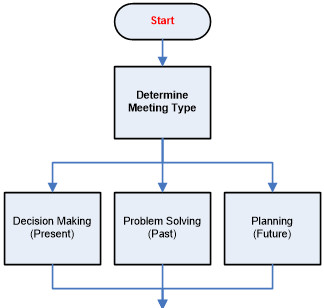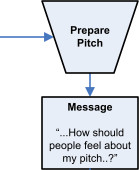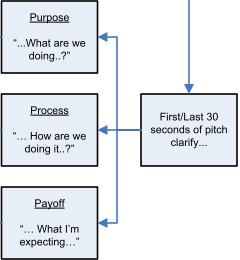I was once told: “Tell them what you’re going to tell them – Tell them – Then tell them what you’ve told them.”
Although this is true, there is so much more to putting together a presentation than just pages in a PowerPoint doc. Most of the steps described below do not involve PowerPoint or any other tool. The steps are to help you and your team determine the message you’re trying to convey, and put together the components needed to do it – Building the actual pitch is one of the last steps. And if you did the planning well… one of the easiest steps.
Determining Meeting Type

Understanding the kind of meeting you’re walking into will help to understand the material you need to present. Consider the three types listed:
- Decision Making: “So what do we do..?” Perhaps the most difficult meeting to prepare for, as you’ve got to put together the key points of information that have surfaced in past meetings and discussions in order to present them and make a final or more important decision. If you’re presenting to your Stakeholders, the meeting could be even more important.
- Problem Solving: “So what happened..?” An easier presentation to prepare for… typically. An example is an Operational Review of an application outage. What happened, how did it happen,and what are we doing to prevent it form happening in the future.
- Planning: “So what’s next…” What should our project look like in 30/60/90 days. Presenting of concepts and ideas.
Planning for the Meeting

The reason that you’re planning for a meeting is to ensure that you’re conveying the message you want your audience to hear, but you need to make sure that you know what it is you’re trying to do! This is a great article in helping you to figure out what you’re looking to say
5 Things that Must be included

Criteria: Definition: http://www.merriam-webster.com/dictionary/criteria. What were the key things that we used in making our decision? If we were judging or evaluation ship building, the criteria might bee thickness of steel, quality of rivets, paint quality, etc. ) Quality: Definition: http://www.merriam-webster.com/dictionary/quality. Distinctive characteristics that makes one thing stand out above or in line with others. Rivets on ship #4 were spaced one inch apart versus the required 2 inch spacing required – making for a stronger
Validation

Make sure that a proper evaluation of the Alternatives, Risks and other possible Decisions are done as a part of the final decision. Show your work when possible.
Preparation

Now… with all of that work done, open PowerPoint and begin to put the pitch together – should be a relatively easy thing to do.
First 30, Last 30

Success!

If you’re interested in a PPTX version of this process, click here or reach out via the contact form.